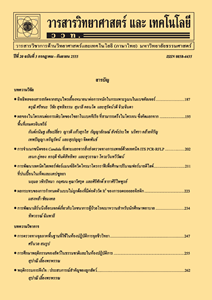การลดค่าลดทอนของสัญญาณของอุปกรณ์ AWG โดยการเพิ่ม TSC ในบริเวณ FPR1
Main Article Content
Abstract
บทคัดย่อ
บทความนี้นำเสนอวิธีลดค่าลดทอนของสัญญาณ (insertion loss) ของอุปกรณ์ 1×8 arrayed waveguide grating (AWG) de-multiplexer ซึ่งขนาดของอุปกรณ์ AWG ที่ออกแบบมีขนาดเพียงครึ่งเดียวของขนาดของอุปกรณ์ AWG ตัวต้นแบบ โดยวิธีดังกล่าวประกอบด้วยการเขียนลวดลายของ transmission star coupler (TSC) เพิ่มเข้าไปในส่วนของ free propagation region 1 (FPR1) ที่มีค่าดัชนีหักเหเท่ากับ 1.455 จากผลการคำนวณพบว่าค่าดัชนีหักเหที่เหมาะสมของ TSC มีค่าเท่ากับ 1.460 ซึ่งขั้นตอนนี้จะช่วยให้แสงสามารถเดินทางในพื้นที่และทิศทางที่กำหนดไว้ ทำให้อุปกรณ์ AWG สามารถส่งสัญญาณแสงไปยัง waveguide ในบริเวณ arrayed waveguide ได้มากขึ้น หลังจากนั้นผู้วิจัยได้ทำการเพิ่มความกว้างของ waveguide ในบริเวณ arrayed waveguide จาก 6 เป็น 8 ไมโครเมตร เพื่อลดช่องว่างระหว่าง waveguide แต่ละเส้น จากการออกแบบโครงสร้างของอุปกรณ์ AWG ดังกล่าว ผู้วิจัยสามารถลดค่า insertion loss ของอุปกรณ์จาก 1.79 เป็น 1.52 dB เนื่องจากอุปกรณ์ AWG สามารถส่งสัญญาณแสงไปยัง output waveguide ได้มากขึ้น โดยที่ขนาดของอุปกรณ์ดังกล่าวยังคงมีขนาดเล็กเท่ากับขนาดของอุปกรณ์ AWG ที่ผู้วิจัยได้ออกแบบในงานวิจัยก่อนหน้านี้ อย่างไรก็ตาม ค่าการรบกวนของสัญญาณใกล้เคียง (crosstalk) ของอุปกรณ์ AWG กลับเพิ่มขึ้น เนื่องจากลำแสงในบริเวณ FPR 1 ถูกบีบให้แคบลง ทำให้จำนวน waveguide ในบริเวณ arrayed waveguide ที่แสงเดินทางผ่านมีจำนวนน้อยลง ส่งผลให้การแทรกสอดของแสงที่บริเวณ free propagation region 2 (FPR2) ไม่สมบูรณ์ ทำให้สัญญาณแสงที่ output waveguide แต่ละช่องสามารถรั่วไหลไปรบกวน output waveguideช่องถัดไปได้มากขึ้น
คำสำคัญ : arrayed waveguide grating; transmission star coupler; ค่าลดทอนของสัญญาณ
Abstract
This paper presents a method for reducing the insertion loss of a 1x8 arrayed waveguide grating (AWG) de-multiplexer. Furthermore, the size of the AWG remains half of that of a traditional AWG. The method involves patterning a transmission star coupler (TSC) into the free propagation region 1 (FPR1). The original refractive index of the patterning process for the FPR1 is 1.455, and through simulation, we found the optimal value of the refractive index of the TSC is 1.460. The role of the TSC is to control the direction and area in which the optical beams travel so as to maximize the amount of light through the arrayed waveguides. We also widen each of the arrayed waveguides from 6 to 8 mm in order to reduce the gaps between adjacent waveguides. Through these improvements, we are able to decrease the insertion loss from 1.79 to 1.52 dB while keeping the size of the AWG as small as in our previous work. The reduction in the insertion loss is due to the increase in the intensity of the optical signal output. However, the crosstalk is increased because the narrowed optical beam inside FPR1 causes the light transmitting in fewer waveguides in the arrayed waveguides than usual. Consequently, the interference of light at the free propagation region 2 (FPR2) is incomplete, and then the higher amount of light from each output waveguides leaks to the adjacent output waveguides.
Keywords: arrayed waveguide grating; transmission star couplers; insertion loss


